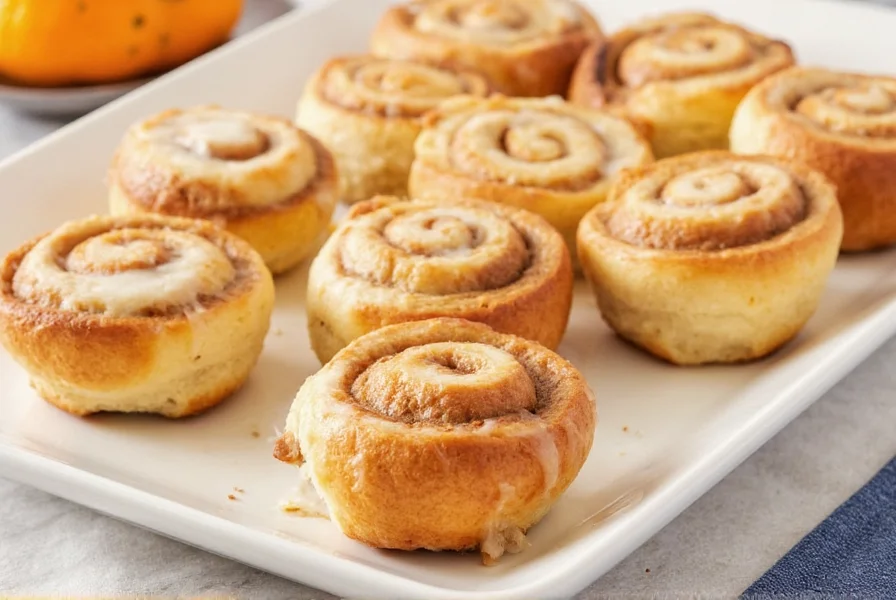Orange cinnamon rolls transform the classic breakfast pastry with a refreshing citrus twist that elevates the familiar cinnamon-sugar combination. This variation works because the bright acidity of orange cuts through the richness of the buttery dough while enhancing the warmth of the cinnamon. Unlike artificial flavorings, real orange zest contains aromatic oils that distribute evenly throughout the dough, creating a more complex flavor experience than standard rolls.
The Science Behind Perfect Orange Cinnamon Rolls
Understanding the chemistry of citrus in baked goods is crucial for success. Orange zest contains volatile oils in its outer peel that provide intense flavor without adding excess moisture. When incorporated into yeast dough, these oils interact with the gluten structure, which is why precise measurements matter. Too much zest can inhibit yeast activity, while too little won't deliver the desired citrus punch.
Professional bakers recommend using 2-3 tablespoons of finely grated zest per standard recipe (yielding 12 rolls). The pith (white part beneath the peel) should be avoided as it contains bitter compounds. For optimal flavor distribution, mix the zest with the sugar in your filling—this creates a protective barrier that prevents the oils from evaporating during baking.

Essential Ingredients Breakdown
| Ingredient | Role in Orange Cinnamon Rolls | Pro Tips |
|---|---|---|
| Fresh orange zest | Provides intense citrus flavor without excess moisture | Use microplane grater; avoid pith; incorporate into both dough and filling |
| Orange juice | Adjusts dough hydration while adding subtle flavor | Replace 25% of liquid ingredients; reduce other liquids accordingly |
| Cinnamon | Creates warm spice base that complements citrus | Use Ceylon cinnamon for delicate flavor; pair with cardamom for complexity |
| Cream cheese | Balances acidity in citrus glaze | Use full-fat; bring to room temperature before mixing |
Step-by-Step Baking Guide
Dough preparation: When making orange cinnamon roll dough from scratch, replace 25% of the milk or water with freshly squeezed orange juice. Add 1-2 tablespoons of zest directly to the wet ingredients. The acidity in orange juice slightly strengthens gluten development, so monitor dough texture carefully—ideal dough should be smooth and slightly tacky but not sticky.
Filling technique: Combine 2 tablespoons orange zest with 1 cup brown sugar and 2 teaspoons cinnamon. The sugar crystals help extract additional oils from the zest. Spread softened butter evenly over the rolled dough, then sprinkle the citrus-sugar mixture, leaving a small border to prevent leakage during rolling. Roll tightly from the long edge for consistent swirls.
Baking considerations: Orange-infused dough may brown faster due to natural sugars in the citrus. Bake at 350°F (175°C) for 20-25 minutes, covering loosely with foil if tops brown too quickly. The rolls are done when internal temperature reaches 190°F (88°C).
Common Mistakes to Avoid
Many home bakers make critical errors when attempting orange cinnamon rolls. Using bottled orange juice instead of fresh zest results in flat, one-dimensional flavor. Overloading the dough with citrus can kill yeast activity—never exceed 3 tablespoons zest per batch. Another frequent issue is adding orange juice directly to yeast, which can lower the liquid's pH and inhibit fermentation.
For the glaze, avoid using only orange juice as the liquid component. The high acidity prevents proper confectioners' sugar dissolution. Instead, use a 50/50 blend of orange juice and heavy cream, or add 1 teaspoon corn syrup to stabilize the mixture. Apply glaze only when rolls have cooled to 120°F (49°C) to prevent melting through the layers.

Storage and Serving Recommendations
Orange cinnamon rolls maintain optimal texture when stored properly. Keep at room temperature for up to 24 hours in an airtight container with parchment between layers. For longer storage, freeze unbaked rolls after shaping—place on parchment-lined baking sheet, freeze solid, then transfer to freezer bags. Bake from frozen, adding 5-8 minutes to baking time.
Serve warm but not hot—allow rolls to rest 15 minutes after baking. The ideal serving temperature (130-140°F) allows the orange oils to volatilize sufficiently for maximum aroma release without overwhelming the palate. Pair with black tea or medium-roast coffee to complement the citrus notes.
Creative Variations Worth Trying
For an elevated orange cinnamon roll experience, consider these professional variations. Add 1/4 teaspoon cardamom to the filling for a Scandinavian twist that complements the citrus beautifully. Incorporate finely chopped candied orange peel into the filling for bursts of intense flavor. For a sophisticated adult version, brush baked rolls with Grand Marnier syrup before glazing.
Seasonal adaptations work particularly well with this versatile recipe. In winter, add a pinch of freshly grated nutmeg to the filling. During summer months, reduce the sugar in the glaze slightly and add a few drops of orange blossom water for a floral note. For holiday presentations, sprinkle edible gold dust over the finished glaze.











 浙公网安备
33010002000092号
浙公网安备
33010002000092号 浙B2-20120091-4
浙B2-20120091-4